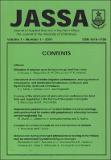| dc.contributor.author | Manzungu, E. | |
| dc.contributor.author | Machiridza, R. | |
| dc.coverage.spatial | Zimbabwe. | en |
| dc.date.accessioned | 2016-02-23T15:58:46Z | |
| dc.date.available | 2016-02-23T15:58:46Z | |
| dc.date.issued | 2001 | |
| dc.identifier.citation | Manzungu, E. and Machiridza, R. (2001) A survey of the distribution of and consumer preference for dried fruits and vegetables in the Harare-Chitungwiza metropolis, Journal of Applied Science in Southern Africa, vol. 7, no.1, pp. 23-41. Harare: UZ Publications | en |
| dc.identifier.issn | 1019-7788 | |
| dc.identifier.uri | https://opendocs.ids.ac.uk/opendocs/handle/20.500.12413/9088 | |
| dc.description | A journal article based on a survey of the distribution of and consumer preference for dried fruits and vegetables in Zimbabwe. | en |
| dc.description.abstract | The distribution of and consumer preference for dried fruits and vegetables in the Harare-Chitungwiza metropolis was studied by conducting two surveys. Data was collected over eight weeks between December 1999 and February 2000. The survey on the distribution of dried fruits and vegetables was conducted in 47 retail shops located in low, medium-and high density areas and the Central Business District (CBD). Low density areas are generally inhabited by high income earners (at least US$909 to Z$50 000 per month) while medium income earners inhabit medium density areas (earning between US$182 and US$909 to Z$10 000 and Z$50 000). The high density areas are home to low income earners earning at most US$182 (Z$10 000). The objective of the survey was to determine the types and brands of dried fruits and vegetables on the market, their source, and to draw a comparison between the prices of fresh and dried products. The products on the market were found to be predominantly from Zimbabwe and South Africa. The distribution of products was found to be related to the socioeconomic status of the hinterland serviced by a particular shop. Low density area shops had more total products (both fresh and dry) than the shops in other residential areas. Shops in the low density areas and the CBD had equal ratios of fresh and dried products suggesting that they were patronised by the same type of clients. Medium density area shops had 16 times more fresh than dried products while shops in the high density areas had no dried products at all. On a weight basis dried products were found to be more expensive than fresh products. Price ratios for dried to fresh products ranged from four-fold for apples (Malus domestics Borkh.) to 20 fold for mangoes (Mangifera indica L.). The survey on consumer preference for dried products was conducted by administering samples of dried fruits; mangoes, apples, peaches (Prunus persica L. Batsch) and pears (Pyrus communis L.) and questionnaires to a total of 120 individuals in the Harare-Chitungwiza metropolis. The survey was aimed at determining the favourite brand of product for each fruit as well as the attribute considered to be the most important by the consumers, in influencing their preference for the products among colour, texture, taste, shape, size and smell. Optimal Scaling Procedures were used to analyse the data. For all fruits colour was considered to be the most important attribute followed by taste and smell, respectively.
Size and texture were considered of less importance in influencing consumer preference. | en |
| dc.language.iso | en | en |
| dc.publisher | University of Zimbabwe (UZ) Publications | en |
| dc.rights.uri | http://creativecommons.org/licenses/by-nc-nd/3.0/ | en |
| dc.subject | Nutrition | en |
| dc.title | A survey of the distribution of and consumer preference for dried fruits and vegetables in the Harare-Chitungwiza metropolis | en |
| dc.type | Article | en |
| dc.rights.holder | University of Zimbabwe (UZ) | en |


